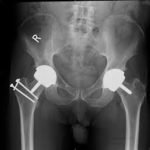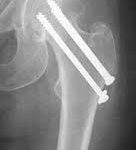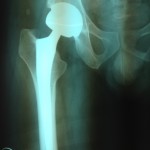Hip fractures are cracks or breaks in the top of the thigh bone (femur) close to the hip joint, sometimes referred to as proximal femoral fractures. It can either occur in the part of the femur inside the socket of the hip joint (intracapsular), or outside the socket (extracapsular).
Symptoms include:
- not being able to lift, move or rotate (turn) your leg
- being unable to stand or put weight on your leg, although in some cases this is possible
- a shorter leg, or your leg turning outwards more on the injured side
Surgery is usually the only treatment option for hip fractures. NICE recommends that someone with a hip fracture should have surgery on the day they’re admitted to hospital or the day after being admitted. In about half of all cases, a partial or complete hip replacement is needed. The rest require surgery to fix the fracture with plates and screws or rods.
The type of surgery you have will depend on a number of factors, including:
- type of fracture (where on the femur it is)
- your age
- your level of mobility before the fracture
- the condition of the bone and joint – for example, whether you have arthritis
TOTAL HIP REPLACEMENT IN AVASCULAR NECROSIS
I was approaching 40. I had a good career, a happy family and everything looked bright for the future. Then one day, I felt a pain in my left hip. I thought it would pass, but it gradually became unbearable. I was diagnosed with avascular necrosis or hip AVN. I couldn’t believe it. Doctors gave me medicines but only the painkillers worked as long as I took them regularly. I went through 14 months of frustration and despair. For my condition, hip replacement was a suitable option, but I was anxious whether I could get back to life 100%. I was worried that I wouldn’t be able to play with my son.
As the pain worsened, my wife kept telling me surgery was perhaps the only way. A friend of mine said that I should go to Udai Clinic as it is one of the most reputed orthopaedic centers in Hyderabad. I met Dr. Udai Prakash who was visiting as a specialist from the UK at that time. He said there was not much point in delaying surgery, as it was the only option. I did some research and found that all over India and globally, people were living active lives after hip replacement surgery. Moreover, I learnt that advances in implant options now allow greater stability and range of motion and may even enable running.
In June 2009, I underwent a ceramic bearing hip replacement. Recovery from surgery was surprisingly smooth. I had very little discomfort. I went through a rigorous rehab program under my surgeon’s supervision. His encouragement and my wife’s support helped me recover quickly. Looking back, I wonder why I delayed the surgery for so long. Within three months, I was back on track. Life felt more precious than ever before. As a result, I became a better husband, a better father, a better professional, and a better member of society. I got a second chance. I have learnt that every challenge is an opportunity to become better. So, never stop moving!




